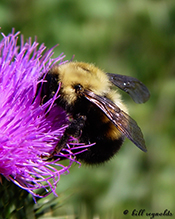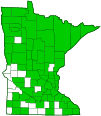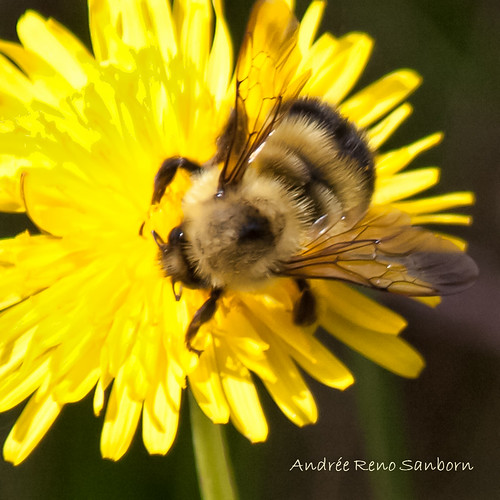half-black bumble bee
(Bombus vagans)
Conservation • Description • Habitat • Ecology • Distribution • Taxonomy
|
|
||||||||||||||
Description |
Half-black bumble bee is a common, small, colonial, ground-nesting bumble bee. The female (worker) bee is ¼″ to ⅝″ long. The head, thorax, and abdomen are densely covered with relatively long hairs. The upperside of the thorax is mostly covered with yellow hairs except for a small, round, black, bare spot in the middle that is more or less fringed with short black hairs. There are six abdominal segments. The first two are densely covered with yellow hairs. On segment 2 the yellow portion is occasionally narrowed slightly in the middle rear (apically) with black hairs. Segments 3 through 6 are entirely black. The hairs on the head are mostly black but there is a dense tuft of yellowish hairs at the top (vertex). There are two large compound eyes, one on each side of the head; and three small simple eyes (ocelli) in a triangular pattern at the top of the head between the compound eyes. The middle ocellus is larger than the the two lateral ones. The top of the small (lateral) ocelli are on a virtual line (supraorbital line) with the top of the compound eyes. There are long black hairs and a few shorter pale hairs around the base of the antennae. The antennae have 12 segments. The first antenna segment is longer than the second or third, but shorter than the two combined. The space below the compound eye (malar space) corresponding to the cheek, is longer than wide. The hardened plate above the upper lip (clypeus) is smooth, shiny, and swollen. The tongue is medium-length. The wings are lightly tinged with brown to dull brick red. The legs are often reddish. The queen is similar but larger. The male (drone) is similar but has 7 abdominal segments and 13 antennae segments. Abdominal segments 3 through 7 are black but with evident yellow hairs at the margins. |
Size |
Queen: 9 ⁄16″ to ¾″ Male: 7 ⁄16″ to ½″ Worker: ¼″ to ⅝″ |
Similar Species |
Sanderson’s bumble bee (Bombus sandersoni) hairs on the top of the head are black. The malar space is square, as wide as long. There are a few yellow hairs on the fifth abdominal segment. The black spot on the upper thorax may be absent or unclear. |
Habitat |
Shady forests, wooded areas, urban parks, wetlands, and gardens. |
Ecology |
Season |
June to August |
Behavior |
Bumble bees will sting to protect themselves or their nest. The stinger is not barbed and the bee can sting multiple times. |
Life Cycle |
Overwintering queens emerge from hibernation in May. They build nests mostly underground but sometimes on the surface of the ground or in hollow trees. |
Larva Food |
Larvae are fed both nectar for carbohydrates and pollen for protein. |
Adult Food |
Adults feed mostly on nectar but also on some pollen. |
Distribution |
||
|
Sources |
|
| 6/25/2024 | ||
Occurrence |
||
Common |
||
Taxonomy |
|
Order |
Hymenoptera (Ants, Bees, Wasps, and Sawflies) |
Suborder |
Apocrita (Narrow-waisted Wasps, Ants, and Bees) |
Infraorder |
Aculeata (Ants, Bees, and Stinging Wasps) |
Superfamily |
Apoidea (Bees and Apoid Wasps) |
Epifamily |
|
Family |
Apidae (honey bees, bumble bees, and allies) |
Subfamily |
Apinae (honey, bumble, longhorn, orchid, and digger bees) |
Tribe |
Bombini (bumble bees) |
Genus |
|
Subgenus |
Pyrobombus |
In the not-too-distant past, bumble bees were often placed in the in the subfamily Bombinae, and sometimes in the family Bombidae. Today, both of these terms are considered taxonomically invalid, though they can still be found in use on the Web. |
|
Subordinate Taxa |
|
Bolster’s bumble bee (Bombus vagans bolsteri) half-black bumble bee (Bombus vagans vagans) |
|
Synonyms |
|
Bombus consimilis Bremus vagans |
|
Common Names |
|
half-black bumble bee |
|
Glossary
Clypeus
On insects, a hardened plate on the face above the upper lip (labrum).
Malar space
In Hymenoptera, the space, equivalent to the cheek, between the bottom of the compound eye and the base of the mandible.
Ocellus
Simple eye; an eye with a single lens. Plural: ocelli.
Minnesota Bumble Bee Identification Guide
The University of MN Bee Lab has a free field identification guide to Minnesota bumble bees. It is indispensable for amateur naturalists or anyone wanting to identify the bumble bee in their photo. Click on the image below to download the guide.
Visitor Photos |
||
Share your photo of this insect. |
||
This button not working for you? |
||
Dan W. Andree |
||
Possible Yellow-banded Bumble Bee... This is from last summer in Norman Co. Mn. Not sure, but possibly it’s a yellow-banded bumble bee. I am realizing I have several species of bumble bees so maybe I should do a short video showing them sometime too. |
 |
|
Half Black Bumble Bee on … Milkweed... This half black bumble bee was feeding on … Milkweed. It would poke its pointed tongue or whatever it’s called in the side of the tips. There were a couple of them in the area feeding that way. At times while I was focusing on something other than a bee I would hear buzzing down by my feet and look down and it was a half black bumble bee just feeding on a plant that was near my feet. Not aggressive at all. I haven’t ran into any aggressive bees even when the prairie is in full bloom during summers. I’ve heard a lot of buzzing at times but never gotten stung while out and about. I do respect the bees and be careful walking walking through heavy feeding areas, but they seem to tolerate my presence and just do what they normally do. |
||
Bobbi Johnson |
 |
… from the garden |
Wendy Everett |
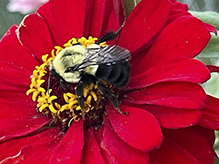 |
Bill Reynolds |
||
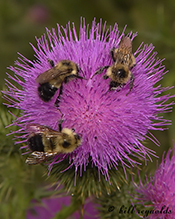 |
||
| The Bull Thistle is alive with bees of all kinds! |
|
|
MinnesotaSeasons.com Photos |
||
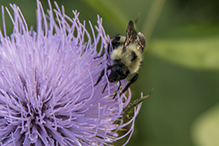 |
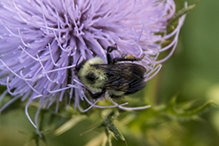 |
|
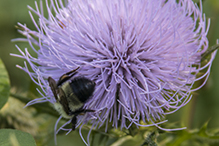 |
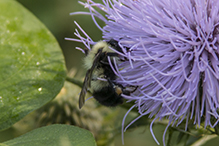 |

Visitor Videos |
||
Share your video of this insect. |
||
This button not working for you? |
||
|
Other Videos |
||
Bumble bees mating |
About
Published on Aug 22, 2013 Queen and drone half-black bumble bees (Bombus vagans) mating. They settled on the rug on the back deck of my house and continued for about an hour before suddenly flying away... |

Visitor Sightings |
||
Report a sighting of this insect. |
||
This button not working for you? |
||
Bobbi Johnson |
Location: Silver Bay, MN … from the garden |
 |
| Wendy Everett 9/29/2022 |
Location: Red Wing, Minnesota |
 |
| Bill Reynolds 9/6/2015 |
Location: Pennington MN The Bull Thistle is alive with bees of all kinds! |
 |
MinnesotaSeasons.com Sightings |
||

Created 9/9/2015 Last Updated: © MinnesotaSeasons.com. All rights reserved. |
